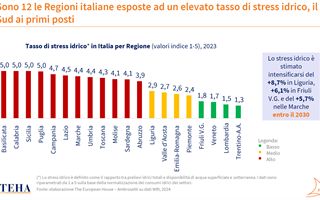(Finance) – The Italian drought has reached worrying levels, so much so that a 51.5% loss of renewable water resources has been recorded in one year compared to the historical average since 1950. This situation is illustrated by the Community Water Value for Italy by The European House – Ambrosetti. In detail There are twelve regions with high water stress and they will increase.
In 2023, rising temperatures and the effects of human action have generated new pressure on water resources. Italy ranks fourth in the European Union for water stress, with an index of 3.3 out of 5. Only Belgium (4.4), Greece (4.3) and Spain (3.9) have worse values. I am already 12 Italian regions with high water stress: Basilicata, Calabria, Sicily, Puglia are the most exposed overall, followed in order by Campania, Lazio, Marche and Umbria, Tuscany, Molise, Sardinia and Abruzzo. Experts – reports the Community Valore Acqua – estimate that by 2030 water stress will further intensify in some Italian regions, with an increase of 8.7% in Liguria, 6.1% in Friuli-Venezia Giulia and 5 .7% in the Marche.
Greater impacts on agriculture and hydroelectricity – Two sectors in particular are most affected by global warming and drought: agriculture and hydroelectricity. Italian agriculture, already subjected to numerous pressures, is facing an increasing scarcity of water which puts food production and the sustainability of agricultural activities at risk. Honey production fell by 70%, pears by 63% and cherries by 60%. Hydroelectricity, which represents a fundamental source of renewable energy for Italy, is suffering due to the reduction of water resources, compromising the country’s ability to meet energy demand through clean sources.
2022 the black year – During 2022, our country faced an unprecedented water crisis. Total precipitation has drastically decreased, and snow cover has recorded a deficit of 60% compared to the average for the decade 2010-2021. Due to the high temperatures, only 13.5% of the rainfall contributed to aquifer recharge. This phenomenon gives rise to further concern, as the renewable water resource is expected to further reduce by 40% by 2100, with peaks of 90% reduction in southern Italy.
The amount of water lost in 2022 – finds the White Paper of the Valore Acqua Community – is equal to that needed to irrigate approximately 641,000 hectares of land, an area corresponding to the entire agricultural surface of Lazio. Furthermore, it is equivalent to the water consumed annually by over 14 million people, i.e. the inhabitants of Lombardy and Piedmont, and the quantity used by the production of 82,000 manufacturing companies, the industrial fabric of regions such as Veneto, Friuli-Venezia Giulia and Emilia-Romagna .
“The water situation in Italy – he explains Valerio De Molli, managing partner and CEO of The European House – Ambrosetti – requires immediate and concerted action. A concrete commitment is needed from all the actors involved, from institutions to citizens, to promote sustainable water management practices and invest in innovative technologies that allow us to face this emergency. It is important to modernize and make our water infrastructure more efficient, to optimize water collection and storage, activating the 20% of potentially exploitable volumes already present in large Italian dams. Only through an integrated and far-sighted approach, which must also be carried forward by citizens, will we be able to guarantee the water security of our country and the prosperity of future generations”.
